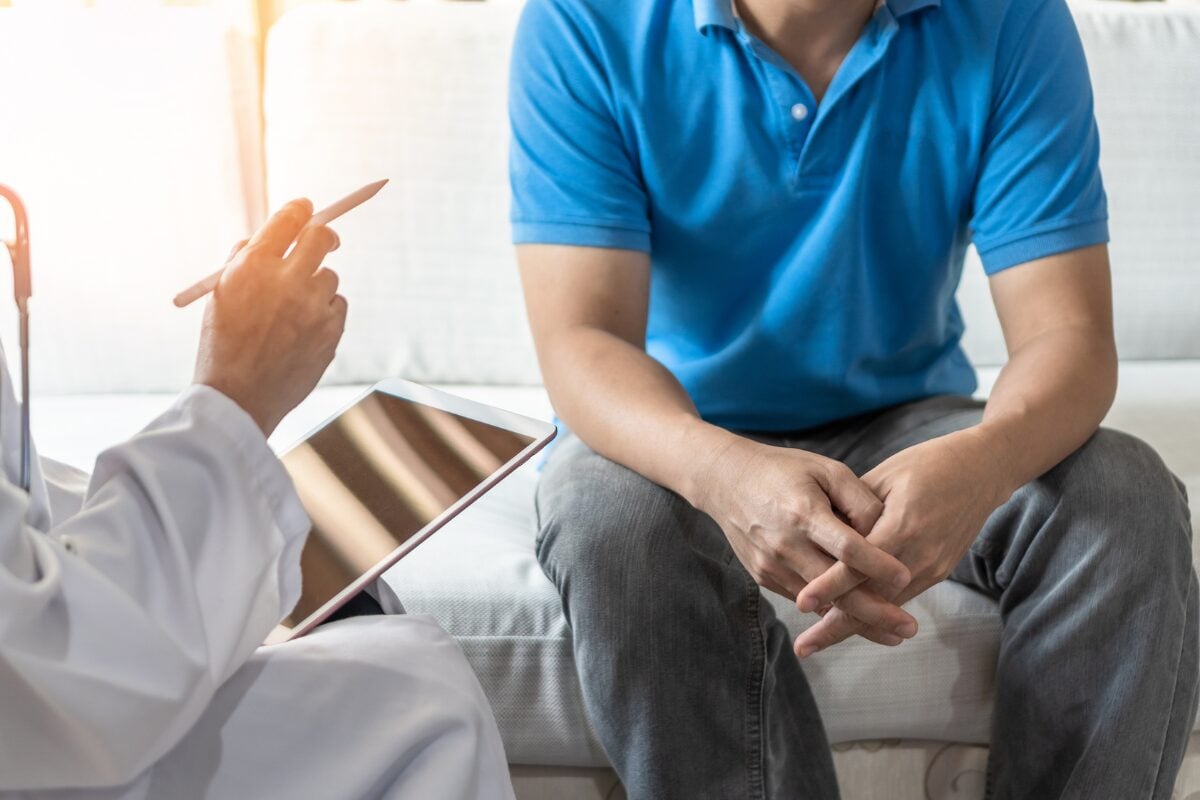What Is Overactive Bladder (OAB)?
JOIN OUR NEWSLETTER
Receive custom tools to help you manage your condition and get the latest in bladder and bowel health from NAFC!
Overactive Bladder, or OAB, is the frequent and urgent need to empty your bladder. Also sometimes called “spastic bladder” or “irritable bladder”, OAB affects an estimated 33 million people in the USA alone. And half of the people with an Overactive Bladder are struggling with Urgency Urinary Incontinence (UUI) when leakage actually occurs.
Overactive bladder can be a nuisance at best, and debilitating at worst. It’s frustrating to constantly be running to the bathroom and can cause anxiety, shame, and even depression when it is also accompanied by urinary incontinence.
Contrary to what many people think, overactive bladder is NOT a normal part of getting older and isn’t something you should think you have to live with. It’s a real medical condition that deserves treatment.
Click here to read Our List Of Frequently Asked Questions About OAB.
Overactive Bladder Symptoms
Urinary urgency: feeling a sudden urge to urinate (even if you just emptied your bladder recently)
Experiencing urge incontinence, or the unintentional loss of urine immediately after an urgent need to urinate
Frequent urination, usually more than eight times in 24 hours
Waking up more than once in the night to urinate (this is called nocturia)
Causes Of Overactive Bladder
To understand the cause of Overactive Bladder, a basic understanding of how the urinary system operates is needed.
The kidneys produce the urine and send it to the bladder. The bladder expands to holds the urine while the sphincter muscle acts as a spiget and controls the flow of urine. Basically on or off. As soon as your bladder gets approximately half full—most people can handle about 2 cups of urine—your brain is signaled that you need to empty it. The bladder muscles contract while the sphincter relaxes. When there is a coordination problem along this system, incontinence occurs.
With Overactive Bladder, a person may be suddenly aware of the urgency sensation but is unable to get to the toilet before losing control of his or her urine. Urine loss can be in large amounts that soak underwear and even outer clothing.
Common triggers like hearing running water or simply the anticipation of urinating can cause a bladder spasm. In some cases, people who have physical limitations may not be able to reach the toilet in time, causing an accident.
Overactive Bladder Treatment Options
Research indicates that most people believe the symptoms of an overactive bladder (urinary urgency, frequency, and/or urgency incontinence) are an inevitable and normal part of growing older, rather than a treatable medical problem. This couldn’t be further from the truth.
In fact, fewer than half of individuals with incontinence actually consult a healthcare provider about their problem. This is unfortunate, since there are many treatments available to combat symptoms of OAB.
Even though it may feel embarrassing to talk about your condition, it’s important to talk to your doctor about your incontinence symptoms. Watch our short film below about the importance of speaking up about bladder leakage.
Management
The first step toward treatment is to visit your doctor. Your doctor will conduct an evaluation and ask you many questions in order to provide an accurate diagnosis. In order to prepare for your visit, take a look at these tips, and visit our resource center for tools you can use to help your doctor determine the best treatment for you.
Behavioral Modifications
Those who take charge  of their condition will discover a variety of treatment options to eliminate, reduce, and manage their condition. Your physician can help prescribe options best suited to the specifics of your condition. This might include:
of their condition will discover a variety of treatment options to eliminate, reduce, and manage their condition. Your physician can help prescribe options best suited to the specifics of your condition. This might include:
Dietary changes. Many foods, like citrus, spicy foods, caffeine, and sugar, can irritate the bladder. By taking note of the foods that trigger urinary urgency, you can then eliminate those foods from your diet, lessening the symptoms of overactive bladder. A bladder diary (a sheet that tracks what you eat and drink, and the leaks you experience) can help with this. Download a bladder diary here.
Fluid management. With supervision from your physician, reduce the amount of dietary irritants (e.g., coffee, colas etc) as well as limiting fluid intake while maintaining 6-8 8oz. glasses of water a day may help with OAB symptoms.
Bladder retraining. Did you know that just like other muscles in your body, your bladder can be trained to hold urine for longer periods of time? This can be an effective tool to help with urinary frequency and urinary urgency issues.
Overactive Bladder Medication
In some cases, medication has proven to be effective. Your physicain may prescribe Ditropan®, Detrol®, Enablex®, Myrbetriq®, Gemtesa®, or other drugs designed to calm bladder nerves.
Antimuscarinics and alpha-blockers are also used. These drugs may affect the brain, so there can be side effects, such as memory loss, reddening of the skin, loss of sight, decreased secretions causing individuals to feel extremely hot, and constipation.
Click here for a full list of medications designed to treat Urinary Incontinence.
BOTOX For Overactive Bladder
If oral medications haven’t worked well for your OAB—or caused unwanted side effects—Botox® may be a helpful next step. Botox® is an FDA-approved treatment that’s injected directly into the bladder muscle to calm the nerves that trigger urgency, leaks, and frequent urination. It’s a quick in-office procedure that takes about an hour from start to finish, and one treatment can provide relief for up to six months.
Clinical studies have shown that Botox® significantly reduces daily leakage episodes, with some people experiencing complete dryness. Most patients only need two treatments a year to maintain results.
Botox® is covered by most insurance plans, including Medicare, and a savings program is available for eligible patients with commercial insurance.
If you’re interested in exploring Botox®, talk with your doctor or find a Botox® specialist here. You can also learn more about cost assistance at BOTOXSavingsProgram.com.
Non-Invasive Treatment
Pelvic Floor Muscle Exercises. Sometimes, weakened pelvic floor muscles are to blame for developing overactive bladder, and the leaks that accompany it. Check with your doctor to see if Kegel exercises are right for you. (Check out our buide for kegel exercises for men here.
Biofeedback. There are many devices which can help tell you how strong your pelvic floor muscles actually are. Some pelvic floor physical therapists may use biofeedback tools during your appointment to not only measure your pelvic floor strength, but to help you learn the correct muscles to engage with performing strength exercises. There are also several biofeedback products available now that can be used within the comfort of your own home.
Sacral Nerve Stimulation. This is an implant that sends electrical stimulation to the nerves that reach the bladder and modulates how the bladder functions.
Surgical Treatment
Surgery is rarely used to treat urgency incontinence. However, if it is severe and refractory, augmentation cystoplasty, or bladder enlargement, can be considered. You will want to consult your physician as well as a urologist to learn more about this treatment option.
Getting Help For Overactive Bladder
The first step in treatment is to ask for help. It may feel funny talking to your doctor about something as private as urinary issues, but rest assured that your doctor is a professional and is here to help. Be prepared before your appointment by keeping a bladder diary for a few days. This will help your doctor see the extent of your problem, and may help him or her to see any triggers that may be causing your urinary urgency issues.
Be prepared to have a thorough discussion with your doctor about your overactive bladder symptoms, as well as any other symptoms you may be experiencing. (Click here to download a free brochure with tips on how to talk to your doctor about OAB!)
You should also let you doctor know if you suffer from any other conditions, such as diabetes, and provide a list of medications you’re currently taking, which may be contributing to your symptoms.
Making a list of questions beforehand is also a great idea to ensure that you don’t forget anything during your appointment. You may want to ask your doctor about different treatment options that he thinks may be a good fit for you, or about any options you’ve read about that you’re interested in trying. Make sure you find out about the potential side effects of any treatment your doctor proposes, as well as what you can expect in terms of a success rate.
Finally, it’s important to remember that while overactive bladder is a physical condition, the emotional toll can be quite significant. Talking with others may help ease that burden. If you don’t have a close friend or family member to talk to, consider signing up for the NAFC message boards to connect with other people living with OAB. Hearing their stories may be just what you need to get through the treatment process
Related Articles

The Ins-and-Outs of OAB
When is that sudden urge to go so bad that you should seek out medical help? How can I tell the difference between a UTI and OAB? How much water should I be drinking every day? Can a woman actually visit a urologist?
These are some of the important questions that we address with today’s guest, Dr. Raveen Syan. She’s an associate professor of clinical urology at the University of Miami’s Miller School of Medicine and a specialist in a number of women’s pelvic health issues, including the treatment of stress urinary incontinence, pelvic organ prolapse and overactive bladder.

Practical Tips for Caregivers Managing Urinary Incontinence at Home
Urinary incontinence is a common and often challenging condition, particularly for aging adults and individuals with certain chronic illnesses or disabilities. As a caregiver, managing urinary incontinence at home can be emotionally and physically demanding, but with the right strategies and products, you can help your loved one maintain their dignity, comfort, and quality of life.
This blog provides practical tips for caregivers who support individuals experiencing urinary incontinence. Whether you’re new to caregiving or looking to improve your current routines, these guidelines can help you approach this sensitive issue with compassion and effectiveness.

Taking Charge: A Man’s Guide to Staying on Top of Health Over 40
Turning 40 can feel like hitting a checkpoint in life. You’ve likely weathered a few storms, gained some wisdom, and maybe even started noticing a few new aches and pains. It’s the perfect time to take charge, prioritize your well-being, and set yourself up for decades of energy, strength, and longevity.
Men often put their health on the back burner—blame it on busy schedules, reluctance to go to the doctor, or simply not knowing where to start. But staying healthy after 40 doesn’t have to be complicated. It just takes a proactive mindset and a little bit of structure.

The Ins-and-Outs of OAB
When is that sudden urge to go so bad that you should seek out medical help? How can I tell the difference between a UTI and OAB? How much water should I be drinking every day? Can a woman actually visit a urologist?
These are some of the important questions that we address with today’s guest, Dr. Raveen Syan. She’s an associate professor of clinical urology at the University of Miami’s Miller School of Medicine and a specialist in a number of women’s pelvic health issues, including the treatment of stress urinary incontinence, pelvic organ prolapse and overactive bladder.







